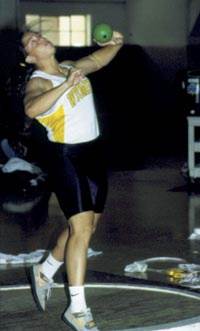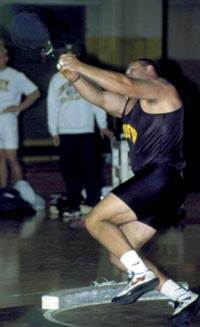UNIVERSITY OF WYOMING: A Thrower's ParadiseLarry Judge has vowed to coach the University of Wyoming into track history, one throw at a time.By Kim Goss Published: Fall 1998 Like most coaches, Larry Judge loves to be part of a team and aspires to head a premiere program that other schools will pattern their own programs after. Also like many coaches, there is a special passion in his heart for his own sport of choice, throwing. Today, as the new track and field coach for the University of Wyoming, Coach Judge may finally be realizing his destiny. Committed to his new position, Judge clearly sees his passion for throwing as key to building up Wyoming's track stats. A former school record holder for Indiana State University in the shot put, 35-pound weight throw and the hammer throw, Judge has 11 years' experience as a coach, five spent as the assistant coach at the University of South Carolina. People who know throwers know Judge, and eyes are already on the Wyoming Cowboys as being a new powerhouse in throwing. In his first year, Judge has been credited with turning All-WAC basketball selection Jesseca Cross into one of the country's top throwers with a good shot at the next Olympic team. Now a grad assistant coach for the Cowboys, Jesseca currently has bests of 57'1" in the shot, 168'4" in the discus, 185'10" in the hammer, and 62'10" in the 20-pound weight throw. On the men's side, Kevin Mannon followed Coach Judge from USC to Wyoming and won both the indoor and outdoor WAC Championships in the shot put, and the 35-pound weight throw in the indoor. He's also one of the few throwers to qualify for three events in the NCAA outdoor nationals. With these two premiere athletes providing additional inspiration, Coach Judge seems well on his way to putting Wyoming at the head of the track and field pack. In a candid interview with BFS, Coach Judge shares some of his creative strategies for turning Wyoming into a thrower's paradise and into one of the finest programs today. BFS: Jesseca Cross is on the verge of becoming an international star in the field events, but isn't it true she was recruited primarily for basketball at Wyoming? LJ: That's correct. She became an All-WAC selection in basketball, and participated in track on a part-time basis, and only in the shot put. BFS: Did playing basketball hold her back in the field events? LJ: I try to recruit athletes who do more than one sport and are good all-around athletes. But there's no substitute for a sound strength and conditioning program that involves the core lifts such as the squat, the bench press and the power clean. When Jesseca was playing basketball, there was just no way she could include the weight training she needed to really excel in these lifts. BFS: Jesseca threw 46'8" in high school in the shot, and in her junior year at Wyoming she had a best of 46'9". In one season you brought her to 57'1". What do you credit this magnitude of improvement to? LJ: I changed Jesseca's focus by having her practice some of the other field events, because I believe they help each other through cross training. I also got her heavily into the weights. BFS: What are her best lifts? LJ: Jesseca's got a 210 bench, 380 squat and a 230 power clean. Another lift she's really outstanding in is the jerk from rack, in which she's done 240 pounds. BFS: With those types of numbers, she would probably do well in Olympic weightlifting competition. Have you considered trying that sport? LJ: We've thought about it, but you know, we just haven't had the time. This past year has been such a whirlwind with her. When I started coaching Jesseca our first goal was to get to 50 feet in the shot, and she did that within a month. Then I decided--what the heck--let's shoot for 55 feet, and she got there in January. Now all of a sudden we're in the top three in the NCAA and challenging for the title. BFS: Now that she's done with basketball and is focusing on track and field, what can we expect from Jesseca in the future? LJ: She has a good possibility of making the next Olympic team in the shot put, and also a chance in the hammer throw. BFS: What is it that sets Jesseca apart from other athletes you've worked with? LJ: Discipline and a strong work ethic. Jesseca came to practice every day ready to lift, ready to throw, and to do all the things necessary--she took care of all the little details, such as being conscientious about her diet and getting enough sleep. And I think it's those little extra things that can make the difference between being a champion and being almost a champion. BFS: Jesseca is now a grad assistant and will be working with your team this season. What are your expectations from her as a coach? LJ: I think the best coaches are those that things didn't come easy for, and she's worked hard for everything she's accomplished. And having carried a 3.8 GPA, she's a great role model for someone entering our program. BFS: Kevin Mannon followed you from the University of South Carolina. Has he lived up to your expectations? LJ: The biggest story about Kevin is the incredible improvements he made in college. Kevin was not a highly recruited athlete in high school and received only a partial college scholarship. But he went from being a mediocre high school athlete to being a nine-time All-American. Very few athletes in the country have made All-American that many times, and he still has one more year! BFS: What are Kevin's best results in the weightroom? LJ: He's got a 500 bench, 650 squat and a 380 power clean. BFS: Some coaches believe that explosive lifts such as the power clean are dangerous. How to you respond to this? LJ: In all my years of coaching I've never had anyone get injured doing a power clean or snatch! I think the coaches who believe these lifts are dangerous are the ones who don't know how to teach them. Honestly, I believe that explosive lifts are injury preventors because they prepare the body for the kind of shock it's going to get when taking a jolt or a hit. BFS: In regard to specificity of training, how many elite-level throwers do you know who do not use the Olympic lifts? LJ: At the elite level, none. BFS: Does the snatch lift have any advantage over the clean as far as the throws go? LJ: It's a quicker lift and can have a place in the training of a thrower, but in a high school situation the power clean may be a little easier to teach. BFS: In addition to weight training, do you do any plyometrics with your throwers? LJ: With heavier athletes, orthopedic injuries are always a concern, so with our throwers we do mostly ground-level plyometrics. However, late in the season we do some box hops and depth jumps, but we're very controlled in the number of foot contacts and only perform these exercises twice a week. BFS: Have you tested Jesseca's and Kevin's vertical jumps? LJ: Yes, Jesseca has a 26-inch vertical and can grab the basketball rim. Kevin has a 33-inch vertical and can dunk very easily. BFS: Has the administration at Wyoming been supportive of the track program? LJ: Our athletic director is Lee Moon, and he's really given us a lot of support. We've been able to upgrade our facility and our equipment, and all this has given Kevin and Jesseca the opportunities to accomplish what they have. Our athletes are able to travel to the meets and get the necessary national exposure. BFS: With the WAC having expanded to 16 teams, how has this affected track and field? LJ: The Rocky Mountain schools have always been traditionally good in the field events and the distance events because of the altitude, and the Texas schools have some of the best sprinters in the country. When you combine them you've got one of the toughest overall conferences in the country. BFS: Are any of the WAC schools still recruiting elite-level track athletes from foreign countries? LJ: You still see a little bit of it, and it mak |
 |
|
Jesseca Cross, now a grad assistant will be a great role model for new athletes entering the Universityís program. |
 |
|
University of Wyoming Throwers Jesseca Cross, Coach Larry Judge and Kevin Mannon. |
 |
|
Kevin Mannonís best weightroom lifts are 500 Bench, 650 Squat, 380 Power Clean |